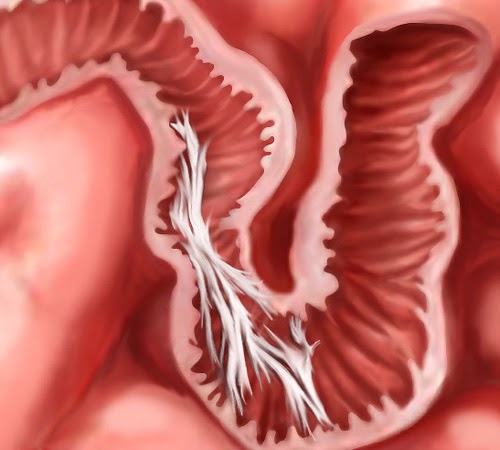Small Blockage in Intestine

A bowel obstruction occurs when there is a partial or complete blockage in either the small or large intestine, preventing the normal passage of food, fluids, and waste through your digestive tract. When you have a small blockage in the intestine, waste, gas, and digestive juices can get stuck behind the obstruction, potentially causing tissue damage and serious complications if left untreated.
Large Bowel Blockage Signs and Symptoms
Recognizing the symptoms of a bowel obstruction is crucial for seeking timely medical intervention. The most common bowel obstruction symptoms include:
- Crampy abdominal pain that comes and goes in waves
- Severe bloating and distension
- Nausea and vomiting
- Loss of appetite
- Inability to pass gas or have a bowel movement (in complete obstruction)
- Diarrhea (often a sign of partial blockage)
- Loud bowel sounds or complete silence in the abdomen
- Signs of dehydration (rapid heartbeat, dark-colored urine)
Small Obstruction Bowel Symptoms
Small bowel obstructions account for approximately 80% of all intestinal blockages and have distinct symptoms. With a small obstruction, bowel symptoms typically include:
- Sharp, intermittent pain that feels concentrated in one area
- Pain that comes in waves every few minutes
- Vomiting that may contain bile (yellowish-green fluid)
- Rapid dehydration
- Abdominal distension that’s often more pronounced in the center or upper abdomen.
More Causes of Colon Obstruction
Understanding what causes intestinal blockages can help in prevention and treatment. The most common causes of colon obstruction include:

- Abdominal Adhesions: Bands of scar tissue that form after abdominal or pelvic surgery are the leading cause of small bowel obstructions in the United States. Read more details on abdominal adhesions.
- Hernias: Segments of intestine can protrude through a weakened section of the abdominal wall, becoming trapped and causing a blockage.
- Cancerous Tumors: Colon cancer is the leading cause of large bowel obstructions, as tumors can grow and block the intestinal passage.
- Inflammatory Bowel Disease (IBD): Conditions like Crohn’s disease can cause scar tissue formation in intestinal walls, leading to narrowing and potential blockage. Learn how Clear Passage can clear strictures in the small intestines.
- Diverticulitis: Inflammation of small pouches (diverticula) in the colon can cause swelling and narrowing of the intestinal passage. Read our blog post on Can Diverticulitis Cause Bowel Obstruction?
- Volvulus: Twisting of the intestine that creates a blockage.
- Intussusception: A condition where one segment of the intestine slides into another segment, causing narrowing or blockage.
Surgical Bowel Obstruction Treatment Options
Treatment for bowel obstructions varies depending on the severity and cause of the blockage. In emergency situations, immediate medical attention is essential.
Conventional Medical Treatments
For severe or complete obstructions, hospital treatment may include:
- Intravenous (IV) fluids to treat dehydration
- Nasogastric tube insertion to remove accumulated fluids and gas
- Medications for pain and nausea
- Bowel rest (temporarily stopping oral intake)
- Surgery to remove the obstruction or repair damaged tissue.
Colon Obstruction Treatment Approaches
Treatment specifically for colon obstructions may involve:
- Stent placement to keep the bowel open without surgery
- Bowel decompression procedures
- Targeted treatments for the underlying cause (such as cancer treatment)
- Surgical removal of diseased or damaged sections when necessary
Downsides of Surgical Treatments of Bowel Obstruction
The downside of surgical intervention for small bowel obstruction (SBO) is a complex issue that extends beyond the immediate operative risks. While surgery remains a critical option for complete obstructions or cases with signs of strangulation, it carries significant complications and challenges that must be carefully considered.
Medication Side Effects
Medication side effects represent a substantial burden for patients undergoing treatment for SBO. Antibiotics, while necessary to prevent or treat bacterial translocation in cases of compromised bowel integrity, can lead to antibiotic resistance, Clostridium difficile infections, allergic reactions, and disruption of gut microbiota. These medications may contribute to prolonged hospital stays and increased morbidity beyond the primary condition.
Source: National Library of Science
Antiemetics used to control nausea and vomiting in SBO patients often come with their own adverse effects. Metoclopramide, a commonly used prokinetic agent, can cause extrapyramidal symptoms including acute dystonic reactions, akathisia, and in rare cases, tardive dyskinesia. This medication is actually contraindicated in complete mechanical bowel obstruction as it may exacerbate crampy abdominal pain by attempting to increase peristalsis against a complete blockage.
Sources: Palliative Care Now and Amboss
Antimuscarinic and anticholinergic drugs, used to manage colicky pain from smooth muscle spasm and bowel wall distension, frequently cause troublesome side effects including dry mouth, urinary retention, blurred vision, and cognitive impairment, particularly in elderly patients. Scopolamine, specifically, can penetrate the central nervous system and lead to delirium, making medication management challenging.
Source: Palliative Care Now
Analgesics, particularly opioids, while effective for pain management, often worsen constipation and may prolong postoperative ileus, creating a frustrating cycle where pain management can exacerbate the underlying condition. This presents clinicians with a difficult balance between adequate pain control and avoiding medication-induced complications.
Source: National Library of Science
Somatostatin analogs like octreotide, sometimes used in malignant bowel obstruction, can cause hyperglycemia, gallstone formation, cardiac abnormalities, and thyroid dysfunction with prolonged use. These medications, while helpful in reducing secretions, add another layer of potential complications.
Source: Palliative Care Now
Fluid Resuscitation
Fluid resuscitation, though essential, carries its own risks, including fluid overload, electrolyte abnormalities, and potential cardiac or pulmonary complications in patients with pre-existing conditions. Aggressive fluid management requires careful monitoring to prevent these adverse effects.
Source: National Library of Science
Perhaps most significantly, the surgery itself creates a paradoxical situation: the very procedure intended to relieve adhesional SBO becomes a major risk factor for developing future obstructions. Research shows that approximately 10% to 30% of patients who undergo laparotomy for bowel obstruction will require another operation for recurrent obstruction due to new adhesion formation. This creates a potentially vicious cycle of surgical interventions and additional adhesion-related complications.
Surgical Procedure Itself
The surgical approach also carries specific intraoperative risks, with inadvertent enterotomy (bowel injury) noted in approximately 20% of open approaches versus 1% to 100% with laparoscopic approaches, depending on case selection. These injuries can lead to peritonitis, sepsis, and significantly increased mortality risk.
Source: National Library of Science
Stent placement, while sometimes used as an alternative or bridge to surgery, especially in malignant obstructions, presents its own complications. These include perforation (3.6% of cases), stent migration (9.8%), reobstruction (9.9%), bleeding (4.5%), and persistent pain (5.1%). In more severe cases, stent fracture can lead to obstruction and colonic perforation, creating potentially life-threatening emergencies.
Source: National Library of Science
Given these significant downsides, non-operative management is increasingly considered for partial SBO without signs of strangulation or peritonitis, with success rates of 60% to 85%.pmc.ncbi.nlm.nih.gov The surgical approach, while sometimes unavoidable, must be carefully weighed against these substantial risks and the potential for creating a cycle of recurrent obstructions requiring multiple interventions over time.
Source: National Library of Science
Bowel Obstruction Recovery Time Without Surgery
The Clear Passage Approach (CPA), a manual physical therapy protocol, can help reduce or eliminate bowel adhesions and prevent future obstructions, offering a non-surgical option for bowel obstruction recovery. The therapy typically involves 20 hours of treatment over 5 days, focusing on decreasing adhesions and improving visceral mobility.
Recovery depends on the severity of the obstruction, overall health, and whether there are any complications. Patients with recurrent partial obstructions may learn to recognize and manage their symptoms earlier, potentially reducing recovery time.
Read more about bowel obstruction recovery time without surgery.
How Do You Clear a Bowel Obstruction Without Surgery?
Clear Passage offers a specialized manual physical therapy that breaks down adhesions causing bowel obstructions by methodically working “cross-link by cross-link,” similar to unraveling a three-dimensional sweater. Published studies show this non-surgical approach reduces recurring obstructions by up to 15 times compared to standard care, effectively clearing intestinal narrowing that would otherwise require surgery and helping patients avoid the harmful “adhesion-obstruction-surgery-adhesions” cycle.
Read more about How do you clear a bowel obstruction without surgery?
Bowel Obstruction Natural Remedies
While natural remedies should never replace medical treatment for bowel obstructions, some complementary approaches may help prevent recurrence or manage symptoms:
- Dietary Modifications: Following a low-residue or low-fiber diet during recovery
- Proper Hydration: Maintaining adequate fluid intake
- Small, Frequent Meals: Eating smaller portions to reduce intestinal strain
- Regular, Gentle Exercise: Promoting healthy bowel function
- Natural Cure for Bowel Obstruction: The Clear Passage Approach
Clear Passage offers a Small Bowel Obstruction Master Class that goes into these bowel obstruction natural remedies in detail.
At Clear Passage Physical Therapy, we offer a unique, non-surgical, non-drug approach to treating adhesion-related bowel obstructions. Our Wurn Technique, a core element of the Clear Passage Approach, is a specialized manual physical therapy program developed over 30+ years to address adhesions that cause bowel obstructions.
Natural Bowel Obstruction Remedies at Clear Passage
Our approach includes:
- Manual Physical Therapy Techniques: Over 200 specialized hands-on techniques designed to decrease bowel adhesions and prevent future obstructions.
- Patient Education: Teaching you how to manage symptoms and reduce the fear of future obstructions.
- Comprehensive Treatment Plan: Addressing the root cause of your condition rather than just managing symptoms, with an individualized treatment plan created just for you!
Bowel Obstruction Non-Surgical Treatment Success
The Clear Passage Approach has been validated through peer-reviewed studies showing significant improvements in patients with histories of bowel obstructions. Research co-authored by physicians from Stanford and Washington University medical schools demonstrated that patients treated with the Wurn Technique experienced significant improvements in:
- Diet Tolerance
- Pain Reduction
- Gastrointestinal Symptoms
- Overall Quality of Life
- Severity of Pain
Our intensive non-invasive physical therapy protocol for small bowel obstructions (SBO) is backed by scientific evidence demonstrating its effectiveness in reducing the need for surgery and preventing future obstructions.
Side Effects of the Clear Passage Wurn Technique
- Temporary discomfort during treatment: The therapy involves applying various site-specific pressures across areas with adhesions, working progressively deeper. While the force is maintained within the patient’s tolerance, some patients may experience temporary discomfort during the manual therapy sessions, which typically last 3-5 hours per day over a week (approximately 20 hours total treatment).
- Post-treatment soreness: As with many forms of physical therapy, patients may experience some muscle soreness or mild discomfort after sessions as tissues that have been manipulated respond to treatment.
- Time and financial commitment: The intensive nature of the treatment protocol (typically 20 hours over a week) represents a significant time commitment and potential expense for patients. However, time invested early can save time and the cost of lengthy hospital stays later.
- Not suitable for all cases: The technique is not appropriate for patients with active bowel obstruction requiring emergency intervention. Clear Passage emphasizes that bowel obstructions can be life-threatening, and immediate medical attention should be sought for active obstructions. Here is a way to manage active bowel obstructions. Clear Passage treats small bowel obstructions due to adhesions, but medical intervention is needed for obstructions caused by tumors, volvulus, and Intussusception.
When comparing treatment approaches for small bowel obstruction, the Clear Passage Wurn Technique presents a remarkably favorable safety profile compared to surgical intervention. While surgery carries significant risks, including medication complications (from antibiotics, antiemetics, and opioids), post-operative adhesion formation that can trigger future obstructions, and potential stent-related complications like perforation and migration, the Wurn Technique offers a notably gentler alternative.
Summary
Bowel obstructions are serious medical conditions that require prompt attention. While severe or complete obstructions often necessitate emergency medical intervention, there are non-surgical approaches available for managing and preventing recurrent obstructions.
Clear Passage Physical Therapy offers a specialized, evidence-based manual therapy approach that has helped many patients avoid surgery and experience long-term relief from bowel obstruction symptoms. Through our unique treatment protocol, comprehensive patient education, and ongoing support, we aim to provide a natural alternative for those suffering from recurring bowel obstructions.
If you’re experiencing bowel obstruction symptoms or have a history of obstructions and want to explore non-surgical treatment options, contact Clear Passage Physical Therapy to learn how our approach might help you regain digestive health and improve your quality of life.


